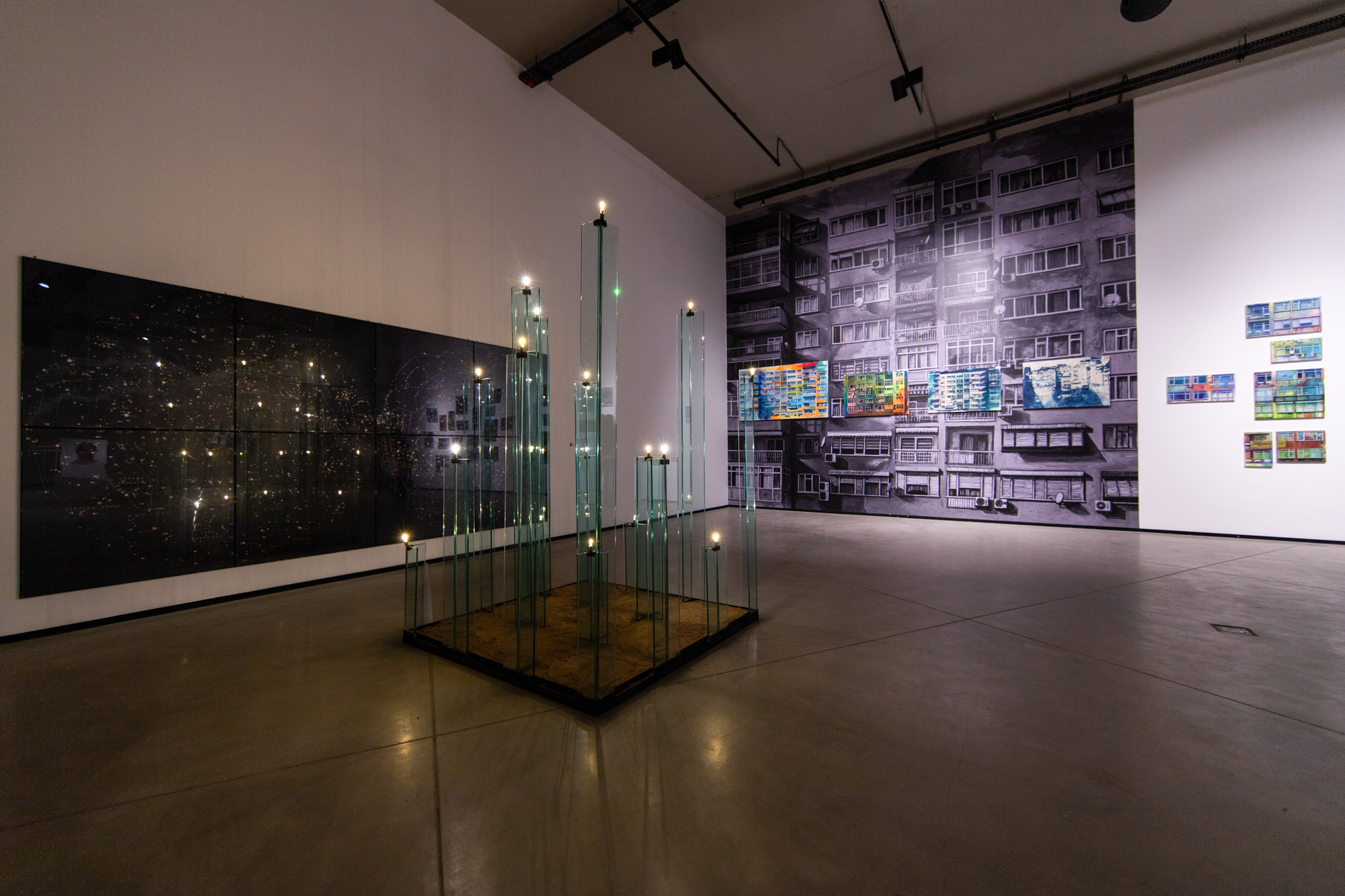Shows
Artists from Turkey “In a Multiple-Perspective”


“In a Multiple-Perspective”
Yarat Contemporary Art Space, Baku
Dec 1, 2022–Apr 30, 2023
The ancient Greek discipline of geometry began by measuring Earth. With the arrival of theoretical mathematics, the abstraction of ideas from observations gave birth to geography, the latter connoting politics inherited from the undead age of empires. But in the process of becoming worldly, the literal patterning of space lost its multidimensional imagination.

Art historian Firat Arapoğlu explored pluralistic interpretations of the prefix “geo” to curate old and new works by Turkish artists in Baku, where ethnolinguistic and military ties bind Azerbaijan to Turkey. While they do not share a physical border, the link between the Turkish and Azeri nations is nonlinear, formed by strong linguistic ties and shared ethnic mythologies. Yet, their mutual neighbor Armenia, despite its immediacy in both nations’ geopolitics, is as invisible in the show as objectivity is in conceptualism.
YARAT, the grandest contemporary art center on the shores of the Caspian Sea, hosted Arapoğlu’s curation, “In a Multiple-Perspective.” With a more reflexive and inward vantage than what the curatorial text proposed, the show critiqued the predominance of Western linear thought and its prevailing dogmas in multicultural aesthetics and international diplomacy.

In contrast to nonlinear order, linearity—based on the assumption of rational purity with its visible sensibility upheld by geometric perfectionism and absolute hierarchy—is utterly distinct from the naturalist surrealism of organic forms or impressionism's uncertainty, emphasizing human modesty as circumscribed by individual or outsider perspectives.
Arapoğlu’s statement quoted British geographer Doreen Massey, who saw national borders as temporal rather than spatial. Investigating the roots of modern cartography and its implications in sociocultural affairs, Arapoğlu curated a rare and vital collection of contemporary Turkish art for the world stage in Baku, despite eluding reference to Armenia, its boundaries remaining among the Central Asian region’s gravest of geographical issues.
Leaning into the blind spots of the censorial and nationalist infrastructures behind the scenes while exhibiting Turkish artists in Azerbaijan, Arapoğlu opened the space at YARAT with a newly commissioned work by the artist duo Özlem Günyol and Mustafa Kunt. The Clock (2022) is a curious sculptural work in the likeness of its titular form, only its dial is void of marked intervals. The turning second, minute, and hour hands of The Clock do not point to a nadir or zenith. They float like a planet in space, as a microcosm of time’s astrophysical origins.
The opening of the exhibition platformed a durational performance by Nezaket Ekici, whose piece drew from the petroglyphs of the nearby municipality of Gobustan, where rock art remains from more than five millennia past. Stripping out of a fashionable dress to expose the furry robe of a cavewoman, Ekici grunted while carving her silhouette into an imposing boulder that overshadowed her. With a crude awl, her laborious and slow grind stood in contrast to Ali Kazma’s video series O.K. (2010) on an adjacent wall, in which a citified notary public stamps documents at a blindingly fast rate.
Across from O.K., the carpet collage series 1001 Nights (2022) by Vahap Avşar, instilled a peculiarly eastward tone albeit infused with the artist’s pop sensibility, rendering the decor he found at Turkey’s antique bazaars into readymade art. Islamic symbology, such as crescents, mosques, and the Kaaba, is scarcely seen among the show’s works, which tend to emphasize design over representation and, in that sense, reflects Azerbaijan’s complex and conflicting Soviet and Muslim heritages.
Yet, upstairs, the video Change Will Be Terrific (2012) by Işıl Eğrikavuk and Jozef E. Amado, played with the increasingly Middle Eastern character of Turkey’s current identity crisis. In the form of a fictive talk show interview with an absurdly ambitious architect, the artists imagined Istanbul’s Taksim Square as host to Egypt’s pyramids of Giza and the Syrian ruins of Palmyra. Extending from the duo’s multimedia installation, a deceptively simple work by Cevdet Erek, Rulers and Rhythm Studies (2007–2011) managed to critique the breadth of Turkish history by placing four numbers on a measuring stick. In appropriately spaced succession, the dates 1923, 1960, 1971, and 1980, when seen together, illuminate Turkey’s founding affinity for putsches, as each year coincides with a coup, including, controversially, the birth of the Turkish republic.
These more didactic inferences are peripheral to the special blend of style and concept that the show imparts. The striking light installation The Zone (1992) by Serhat Kiraz is well-paired with Selcuk Artut’s Geomart-ut8 (2022). The former’s constellated mechanical bulbs are retro in comparison to the latter’s sharply motional, optical digitization of overlapping and warped lines.
Yet, mired by its selective plurality, “In a Multiple-Perspective” attempts to accommodate innovative and ideational diversity at the expense of pointed coherence. The introspective, even solipsistic gestures of the exhibition repeated art world myopia and failed to liberate the rarefied internationalism of its Turkish artists’ emergence in regional, civic space vis-à-vis YARAT’s efforts to foreground Azerbaijan’s relatively obscure contemporary art scene. Instead, despite inviting a roster of iconoclasts from Turkey, “In a Multiple-Perspective” accented the institutional rigidity that confines and isolates the nonlinear, often remote work of eccentrics who remain on the fringes of global culture, or wholly off the grid, and not only geographically.







